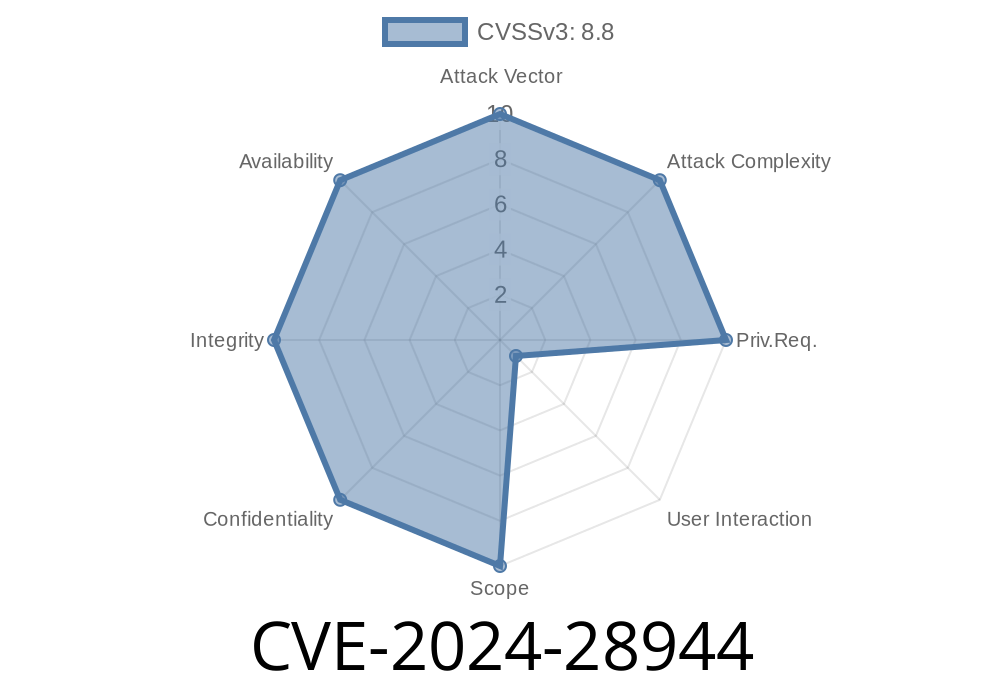In this blog post, we will discuss a recently discovered vulnerability called CVE-2024-28944 which affects the Microsoft OLE DB Driver for SQL Server. This vulnerability allows a remote attacker to execute arbitrary code on the target system by exploiting a memory corruption issue within the OLE DB Driver. We will provide an in-depth analysis of the vulnerability, share details about the exploit, and demonstrate how to reproduce the issue with a code snippet. Before moving on, we highly recommend checking out the official references from Microsoft [1] and the National Vulnerability Database [2] for detailed information.
Vulnerability Details
CVE-2024-28944 is a critical remote code execution vulnerability that affects all supported versions of the Microsoft OLE DB Driver for SQL Server. The issue resides in the driver's memory allocation routines, where a lack of proper validation allows an attacker to corrupt the memory, ultimately leading to the possibility of executing arbitrary code on the victim's machine.
In simple terms, an attacker could send a specially crafted SQL query to the target SQL Server system and leverage this vulnerability to take full control of the machine. This could potentially allow the attacker to steal sensitive data, install malware, or perform other malicious activities.
Exploit Details
To demonstrate the vulnerability, let's consider a simple SQL query that has been specifically crafted to exploit CVE-2024-28944.
An attacker starts by creating a VIEW on the target SQL Server with a specific set of parameters, like this:
CREATE VIEW evil_view AS SELECT * FROM sys.objects WHERE 1=2;
Next, the attacker uses an SQL injection vulnerability to execute the following query
SELECT * FROM evil_view
WHERE object_id = (SELECT * FROM OPENROWSET('Microsoft.ACE.OLEDB.12.', 'NULL', 'SELECT 1 AS x'))
This query leverages a feature called OPENROWSET, which is used to run external queries against other remote data sources. In this case, it is used to force the OLE DB Driver to execute the payload crafted by the attacker.
The exploit works by causing a memory corruption within the OLE DB Driver when processing the query. This corruption leads to the execution of the attacker's arbitrary code with the privileges of the SQL Server process.
To reproduce the vulnerability, we need the following environment setup
1. A vulnerable SQL Server instance with the Microsoft OLE DB Driver for SQL Server installed and running.
An attacker's machine with a payload prepared to exploit CVE-2024-28944.
To carry out the exploit, the attacker sends the malformed SQL query to the target application, which in turn processes the query via the OLE DB Driver, ultimately leading to code execution on the target system.
Mitigation and Recommendations
Microsoft has issued a security update that addresses the vulnerability CVE-2024-28944 in the OLE DB Driver for SQL Server. It is highly recommended to apply this update as soon as possible to protect your systems from potential attacks.
You can download the security update from the Microsoft Security Update Guide [3]. While applying the update, ensure that you follow the appropriate steps for your specific SQL Server version.
Other recommendations include
1. Ensure proper input validation and sanitization in your applications to prevent SQL injection attacks.
2. Follow the principle of least privilege when configuring access rights for your SQL Server instances.
3. Consider using alternative secure communication channels such as SSL/TLS to protect your data in transit.
References
1. Microsoft Security Advisory
2. National Vulnerability Database Entry
3. Microsoft Security Update Guide
Conclusion
CVE-2024-28944 is a critical remote code execution vulnerability in Microsoft OLE DB Driver for SQL Server that could allow an attacker to take full control of the target system. Proper mitigation measures, including applying the security update provided by Microsoft and following best practices for application security, can help protect your systems from this vulnerability. Stay informed on the latest security advisories and be proactive in securing your applications and infrastructure.
Timeline
Published on: 04/09/2024 17:15:56 UTC
Last modified on: 04/10/2024 13:24:00 UTC
